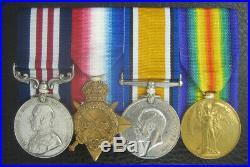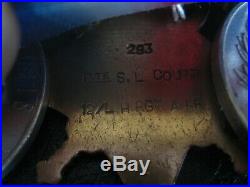











A FINE WW1 AUSTRALIAN 1917 YPRES M. GROUP TO A 56 BATTALION AIF NCO AND EX 12TH LIGHT HORSE REGIMENT GALLIPOLI VETERAN, HE WAS LATER COMMISSIONED LIEUTENANT. 56/AUST: INF:; 1914-15 STAR 283 PTE. BRITISH WAR AND VICTORY MEDALS LIEUT. Was attached to the 5th Divisional Pack Transport Troop for just over a week between 22nd September 1917 and 1st. Within days he would be Awarded MM for Gallantry supplying the front line around Glencourse Wood. At the start of the 5th. Divisions attack on Polygon Wood. London Gazette 12 December 1917. The original recommendation states. On two occasions Sergeant Court displayed courage and resource on convoy duty in the vicinity of Hooge and Glencourse Wood in rallying men and keeping convoy intact under shell fire at night on 25th and 26th September 1917. A 24 year old Labourer from Bingara enlisted in the Australian Imperial Force on 8th January 1915. March 1915, Court joined the 12th Light Horse Regiment, at. Which was then forming and was assigned to B troop. On completion of forming the Regiment embarked for. In two groups, the first on 11th June 1915 aboard HMAT A29 Suevic including. During the voyage to. The part of the 12th Light Horse Regiment travelling on the HMAT A29. And landed on 12th July 1916 to bolster the defences of the British garrison which was under pressure from Yemeni tribesmen who were threatening an attack. By 18th July no attack had occurred and the threat diminished allowing the Regiment re-embarked to. Prior to landing on Gallipoli, the 3 Squadrons of the 12. Light Horse were attached to other Light Horse Regiments already serving on the Peninsular. B Squadron became D Squadron of the 7th Light Horse Regiment, serving with them at Gallipoli from 29. During their time at Gallipoli, the 7. Light Horse were deployed on on the far right of the front line, in the southern regions of Anzac. November, his departure having been delayed so he could serve 14 day No2 Field Punishment for gambling! Court remaining with the 7. Light Horse in Gallipoli until they were evacuated on 20th December 1915. Transferring back to the 12. Light Horse when it reformed in. February 1916, he was promoted Corporal the next day. Court would continue to serve with the Light Horse, the Regiment moving to the. Taking part in its defence. June 1916 Court was admitted to hospital with conjunctivitis. June he was invalided to. Spent the following 6 months in hospital, recuperating and then training in. Until transferred to the 56th Australian Infantry Battalion on 2. February 1917, serving with them until the end of the War. He was promoted Temporary Sergeant on 27. May 1917 being confirmed to that rank in August. SERVICE WITH 56 BATTALION AUSTRALIAN INFANTRY. On 14 February 1916 as part of the “doubling” of the AIF. Half of its recruits were Gallipoli veterans from the 4th Battalion, and the other half, fresh reinforcements from. In early 1917 the 56th Battalion participated in the advance that followed the German retreat to the Hindenburg Line. It was spared the assault but did, however, defend gains made during the second battle of Bullecourt. Later in the year, the AIF’s focus of operations switched to the Ypres sector in. The 56th’s major battle here was at Polygon Wood on 26 September. With the collapse of. In October 1917, a major German offensive on the Western Front was expected in early 1918. This came in late March and the 5th Division moved to defend the sector around Corbie. The 14th Brigade, took up positions to the north of Villers-Bretonneux and held these even when the village fell, threatening their flanks. Once the German offensive had been defeated, the Allies launched their own offensive in August 1918. The 14th Brigade did not play a major role in these operations until late in the month, but its actions were critical to the capture of Peronne, which fell on 2 September. The 56th fought its last major battle of the war, St Quentin Canal, between 29 September and 2 October 1918. It was resting out of the line when the Armistice was declared on 11 November. It ceased to exist as a separate entity on 10 April 1919, when the remnants of all of the 14th Brigade’s battalions were merged into a single unit. Probably due to his mounted service experience. Was attached to the 5th Divisional Pack Transport Troop for just over a week between 22nd September 1917 and 1. At the start of the 5. 5TH DIVISIONAL PACK TRANSPORT TROOP, FROM THE STORY OF THE 5TH DIVISION. An important administrative event of the Blaringhem period was the formation of a Divisional Pack Transport Troop. This was a large troop of about 300 pack animals, and the necessary animals and personnel were secured by uniting under one organisation detachments of men and animals from the whole of the transport units of the Division. The idea was to centralise all forward pack transport under one control in order to ensure equal distribution in the work of supply in the forward areas. Under the old arrangement, which worked well enough in easy sectors, it might happen that a brigade in the line had so many casualties in its pack animals, or might so overwork them, that its forward supplies would partially break down, while the pack animals in another brigade in reserve would be having very little work to do. Centralising the pack animals of the entire Division under one control would obviate any danger of this and would also secure equal distribution of work to men and animals. The chief argument against the innovation was that transport personnel would work better if they felt that they were labouring for their own units, instead of partially losing their identity in a Divisional Troop. General Hobbs and Colonel Bruche weighed the matter carefully, and decided that the certainty of regular supplies reaching every unit of the Division must be the first consideration, even if a very natural sentimental repugnance existed to a temporary loss of unit individuality. Curtis (5th Divisional Train) was made O. Divisional Pack Transport Troop and under his control it soon became involved in work of the greatest importance. The Divisional Pack Transport Troop was located about half-way between Dickebusch and. Staff Captains of brigades intimated daily the number of pack animals required for each unit in the brigade, and these animals reported every evening at the quartermaster’s stores of the various units. Here they were loaded up with the next day’s issue of food and water and carried it, under the direction of guides supplied by the units concerned, to wherever it was wanted. By means of the Divisional Pack Transport Troop, eighty-four pack animals more were available for the work of supplying the forward units than would have been the case if each unit had worked its own pack transport. This result was attained partly by reason of the fact that the supplies of the reserve brigade could be delivered on wheels by the Divisional Train. On the 28th of October the Division was relieved on the Broodseinde Ridge by the 2nd Australian Division and D. Moved back again to Scottish Lines on that date. The Divisional Pack Transport Troop having admirably fulfilled the purpose for which it was created, was disbanded on the same day and Capt. Curtis and his fine staff were able to look back on a hard task well and faithfully carried out. Many of their animals had been killed by shells or drowned in the mud and few people in the Division were more familiar than the Transport personnel with that hideous road which wound past Hell Fire Corner, Birr Crossroads and Bellevarde Lake up the Westhoek Ridge, and thence on to the Broodseinde Ridge. Major Langley and his provost and traffic control detachments, too, and the 5th D. Were on it night and day and the sustained heroism of these men and of the medical and signal details employed in the same area almost equals that of the front line troops. Continued to service with 56 Battalion and after a spending February 1918 in hospital, was detached again to 5. Division HQ (Salvage Party) from 15. In August 1918, Court was sent to. To join the Cadet Battalion and was commissioned Second Lieutenant 56 Battalion on 4th January 1919. In Courts Cadet report, it notes his Standard of Education is Poor and regarding ability to train a platoon; His knowledge is not very good. He can instruct when he knows the subject. However regarding ability to Command a platoon, he was noted as Good and under Special Qualifications; Riding. Would have completed his course 10. He has been handicapped by lack of education but has worked hard and with some knowledge will make an instructor. His command over men is good. I consider that he will make an efficient platoon commander. Was sent back to 56 Battalion in. He was finally discharged from the Army on 2. A superb group to a soldier who saw a great deal of action at both Gallipoli with the Light Horse, France with the Infantry and a rare MM to the 5. Division Pack Transport Troop, a short lived unit within the Division. Condition VF or better, mounted for display, light contact marks overall. SEE MY OTHER AUCTIONS FOR MORE WW1 AIF GALLANTRY AWARDS. PLEASE NOTE; If you have any questions and require more images please get in touch. KEYWORDS: MEDAL MEDALS BOER KILLED WOUNDED BRIGADE AWARD CAPTAIN COMMANDER LIEUTENANT OFFICER KILLED WOUNDED 1815 AUSTRALIAN NEW ZEALAND ANZAC AIF GALLANTRY SOMME YPRES GALLIPOLI LIGHT HORSE INFANTRY BATTALION WW1 WW2. The item “WW1 AUSTRALIAN MM GALLANTRY MEDAL GROUP EX LIGHT HORSE GALLIPOLI VET” is in sale since Friday, January 3, 2020. This item is in the category “Collectables\Militaria\World War I (1914-1918)\Medals/ Ribbons”. The seller is “albatrosj1″ and is located in SCOTLAND. This item can be shipped worldwide.